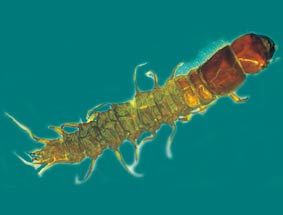Major Group: Insecta
Order: Megaloptera
Family: Corydalidae |
Descriptive Features: head and pronotum rather smooth, with only scattered long hairs
left mandible with 4, right mandible with 3 teeth on inner margin (in addition to apical tooth)
apical 2 segments of antennae combined about as long as segment 2
abdomen with 8 pairs of non-articulated lateral processes (gills)
thorax and abdomen without prominent intersegmental lobes
posterior pair of spiracles each raised (generally) or not raised (rarely) on a definite stalk
lateral processes of abdominal segments 1-5 longer than width of respective segment
apical segment of abdomen with pair of prolegs but without terminal filament
Total length: |

|
Archichauliodes sp. |
|
|
|
Taxonomic Checklist: Genera
Apochauliodes cervulus Theischinger
Archichauliodes 18 species
Protochauliodes 3 species |
|
Distribution: SE NSW, E Vic, SWA, NE Qld, ACT
Sensitivity Rating: SIGNAL grade 7
Functional Feeding Group: predators |

|
Molonglo River, Coppins Crossing ACT |
|
|
Ecology: Instream habitat: Corydalid larvae occur in spring seepages, streams, rivers, swamps, ponds and lakes. They are usually associated with clear, cold waters, but some records are from swamps. Larvae live under rocks and debris, even in the mud and silt. Adults are found on the stems of riparian vegetation.
Feeding ecology: Larvae are active predators, feeding on small aquatic invertebrates. Most adults do not feed.
Habit:
Life history: Mating takes place in vegetation near water with the males and females communicating by vibration signals. Females lay their eggs in compact masses, of 200 to more than 300, on vegetation or on rocks over-hanging or emerging from water. The eggs are generally placed in positions protected from the sun. Many females aggregate their egg laying such that the total egg mass cover considerable areas and resemble lichens encrusting rock. Eggs hatch in one to four weeks. After hatching, larvae drop into the water and sink to the bottom. Larvae pass through 10-12 instars. Archichauliodes larvae move to high water marks in spring and early summer and are left on the banks as the water dries up. They construct a simple larval chamber in the soil and litter and may remain in the active larval stage for several months before pupation takes place. The pupal phase lasts only a couple of weeks. Adults are short lived and emerge in late spring to autumn. The life cycle of Megaloptera ranges from one to five years. |
| |
Information Sources: Theischinger 2000a, Theischinger & Houston 1988
Key to Genera: Theischinger 2000a
Key to Species: Theischinger 2000a (Archichauliodes species groups) |
|
|
|